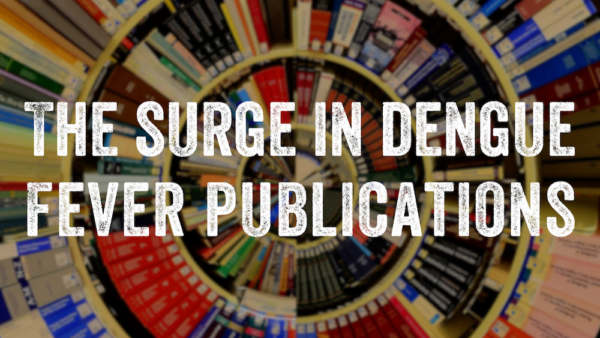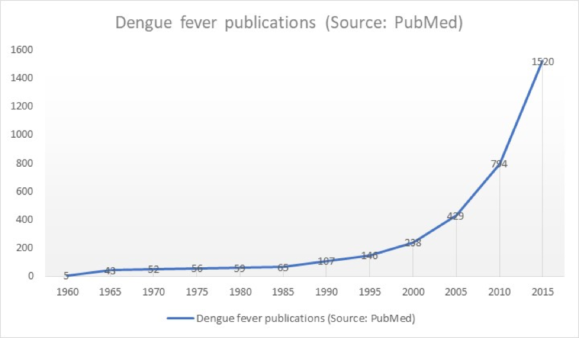- by Gary Finnegan
Surge in dengue fever publications

The number of dengue fever publications has grown strongly since 1960.
According to an analysis of PubMed, performed by Break Dengue, just five search results were returned for ‘dengue fever’ in the year 1960. This rose gently until the late 1990s when the graph turned upwards. After that, growth was exponential. In 2015, more than 1,500 papers were published on dengue fever.
This reflects the strong growth in academic and public health interest in dengue fever, as well as increased research funding for this serious disease. The trend follows a growth in the number of cases of dengue worldwide – and reflects the urgent need to contain its spread.

Dengue fever publications: highlights from 2017
This year has seen several notable dengue publications on topics ranging from mosquito control and dengue treatment to disease surveillance and the burden of disease including the economic cost of dengue.
1. Lancet Infectious Diseases published a study by Castro, Wilson, and Bloom – all from Harvard – on the large and growing burden of dengue fever. The paper explores not only the number of cases but the economic impact of outbreaks.
2. A study published in BMC Infectious Diseases looked at early warning signals for dengue outbreaks in Colombia using a mix of climate and other data. Colombia faces a range of competing, health challenges. An early warning system would help decision-makers to prioritize how they use resources and getting better value for money.
3. A paper by experts in Taiwan explores the role of public transport in the spread of dengue in urban settings. The authors look at metro passenger numbers and how this relates to dengue outbreaks. They found that large flows of passengers through metro stations can dramatically increase the risk of dengue in the neighborhood.
4. The disease burden of dengue in the Philippines is the focus of a study published in the American Journal of Tropical Medicine and Hygiene. The authors aim to address the underreporting of cases in order to get a more accurate estimate of the trust burden of disease. We will have an interview feature on this topic in the coming weeks.
5. Looking ahead, an important publication is due for a release this coming summer examining the role of search engines in tracking dengue. While this paper remains under embargo, we can whet your appetite by saying that it looks at the potential of combining search engine data with official clinical information in five countries. Watch this space.
What is clear is that the commitment among academics and funding agencies to understanding dengue fever is stronger than ever. So too is the level of diversity we see in the kinds of papers being published. No longer are dengue fever publications the exclusive domain of mosquito experts and biochemists, economists and mathematical modelers have entered the fray.
The big question is whether the growth in knowledge from multiple disciplines can be translated into strategies that improve our power to break dengue.
—

